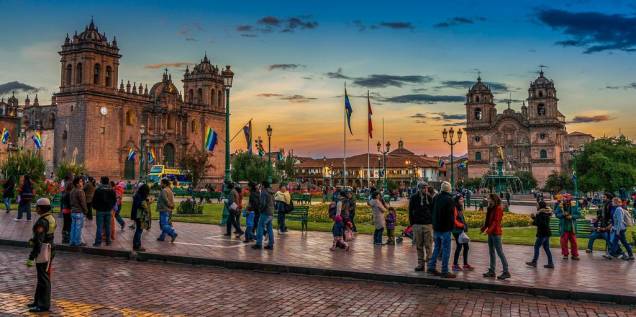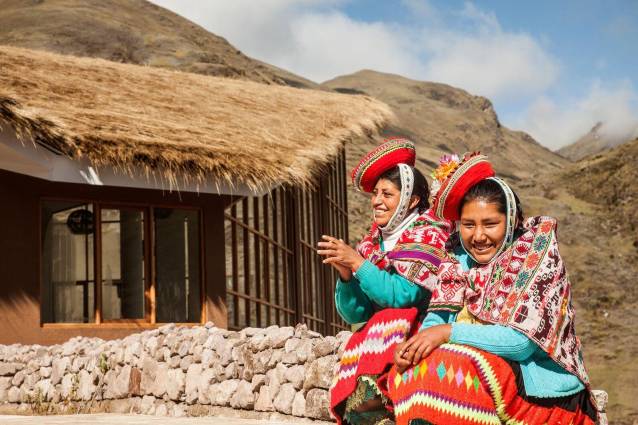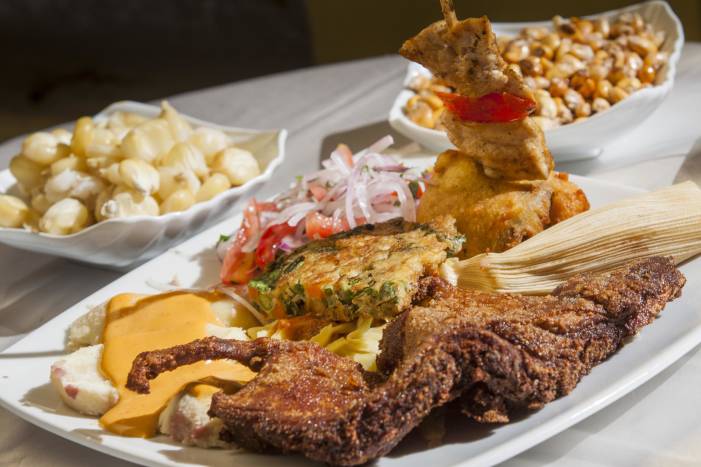In travel, first impressions are extremely important, and the ancient city of Cusco, Peru, at first glance could hardly be more inviting. Peaceful, orderly, chock full of history and culture, brimming with services and distractions, and mostly unburdened by the hard sell of many other top-tier tourist destinations, this former capital of the Inca Empire is more than able to satisfy the needs of travelers of all bents and budgets.
In fact, one of Cusco’s only shortcoming, particularly for new arrivals, is shortness of breath. And not just because of its beautiful sites. It is common for visitors to feel the elevation – about 3,400 meters or 11,150 feet. Fortunately, the frequently expressed advice to acclimatize by drinking mate de coca (no sugar!) and just taking it easy for a couple of days is perfectly in keeping with the city’s equable calm.
With that tea-sipping tranquility in mind, this beginner’s guide to Cusco will help new arrivals make the most of their first few days in this oldest continuously inhabited city in the Americas, now also a UNESCO World Heritage Site.
Plaza de Armas and Surrounding Area
Foremost in most visitors’ minds is Cusco’s main square: the enchanting portico-lined Plaza de Armas. Once known as Huacaypata, it has been the heart of the city since Incan times and retains an impressive sense of uniqueness and authenticity, even as it absorbs hundreds of gawkers and hawkers.
Dominating the plaza’s northeastern flank is the cathedral, completed in 1669 between two older churches. Paid guided afternoon tours cover the highlights inside – the monumental silver altar; the intricately carved cedar wood choir stalls; the 400-plus 16th- and 17th-century paintings by artists in the Cusco School – but a visit during morning mass bypasses the entrance fee (though it loses out on the insights). On the southeastern side of the plaza is the ornate Baroque façade of the Campañia de Jesús, a 16th-century Jesuit church with a magnificent gold altarpiece.
Within easy reach of the plaza are other monuments and museums, each worthy of a visit:
To the southeast is Santo Domingo Church, built on the magnificent ruins of Coricancha, the famous Inca Temple of the Sun; sections of the cloister have been removed to reveal the incomparable Inca stonework of four original chambers. Also nearby is the Museo Machu Picchu, which includes the recently returned collection of 360+ artifacts removed by Hiram Bingham, whose 1911 “discovery” of Machu Picchu brought it to worldwide attention.
A short uphill hop northeast of the plaza are the Museo Inka, which walks through Peruvian civilizations from pre-Inca to Inca in a lovely 17th-century colonial mansion; and Museo de Arte Precolombiano, whose 450 pieces from 1250 BC to 1532 beautifully chronicle artistic expression in ancient Peru.
To the southwest is the Museo Historico Regional, once home to Inca Garcilaso de la Vega, an important 16th-century writer of Spanish and Inca heritage.
All around the plaza are great examples of hard-to-miss surviving Inca walls, used as foundations for colonial structures. Calle Loreto contains the oldest surviving Inca wall in Cusco, while Calle Hatunrumiyoc boasts the much-photographed 12-sided stone (a large meticulously shaped stone).
Barrio San Blas
Northeast of the plaza is the San Blas neighborhood, a popular area of steep stone-paved streets, stunning city views, art galleries and studios, artisans workshops and shops, bars and pubs. Not to be missed are the adobe Templo de San Blas (the city’s oldest parish church, containing a beautiful cedar wood pulpit carved from single tree trunk) and the Mirador, a quiet, viewpoint with amazing city views.
Nearby Inca Ruins
There are four Inca ruins located a short distance to the north of downtown. The largest, nearest and most significant is Sacsayhuaman, once a massive fortified complex with huge walls made of rocks 11 feet tall and weighing more than 300 tons. Further up the hill are Q’enko, a religious site; Puca Pucara, meaning “red fort,” but of unclear purpose; and Tambomachay, a place of water ceremonies and worship.
Culture on Display
Peruvian women in full traditional dress, many with alpacas or baby lambs on a leash (for a small tip, they’ll pose for pictures) and selling traditional textiles, bring great color, culture, and trinkets to the streets of Cusco. But there are also more formal outlets that celebrate the ancient practices of today’s Quechua peoples.

For information about weaving and textiles, look for shops associated with good causes, like the Centro de Textiles Tradicionales del Cusco and Inkakunaq Ruwaynin, where sale price go to the artisans. They tend to be expensive, but the work is unquestionably excellent. The Centro de Textiles also has a small but very informative museum. For cheaper textiles, keep an eye out for the many shops (some filling large internal courtyards) in the streets adjacent to the main square. For alpaca wool clothing, jewelry and ceramics, there are also many specialty shops.
Apropos of shopping, not to be bypassed is the San Pedro Market, buzzing with life, energy and a broad selection of local food ingredients (including cheeses, bread, and juice bars), prepared food (the best cheap meals in Cusco), tchotchkes and other souvenir wares. It’s a fantastic slice of local life.
For more organized cultural displays, the Qosqo Native Art Center is very popular. It hosts the “First Group of Folk Music and Dances of Peru,” whose cast of 70 artists has been presenting a repertoire of 50 dances since 1924.
Where and what to eat in Cusco
The abundance of eateries in Cusco is astounding. From the previously mentioned food stalls in the San Pedro Market and street-side cubby-sized inns to the now common wood-fired pizza or Peruvian-style roast chicken places and even the fine-dining restaurants of Peruvian megastar chef Gastón Acurio, there’s definitely something for everyone.
Mid-day meals are typically served from a menú del día, which consist of a hearty soup, like the local chairo, and choice of a second course (usually a typical meat dish), sometimes also including a drink and/or dessert. For vegetarians, the city now counts numerous meat-free places, from food stalls in the smaller San Blas Market to upscale “green” restaurants in or near the major plazas.
The list of must-try foods is probably as long as that of the must-see sites in the neighboring Sacred Valley. Top of the heap is cuy, or guinea pig, a Peruvian staple meat that is better roasted than fried, but both very tasty. Alpaca steaks are also a novelty. Less unusual are chicharrones (pork deep fried in lard), whole grilled trout (trucha), various escabeche and ceviche dishes, lomo saltado (a beef stir-fry), aji de gallina (chicken in a yellow aji pepper sauce) and so much more!

A typical Cusco morning treat, available in San Pedro Market, is a caldo de gallina, a steaming bowl of soup loaded with boiled chicken, spices, vegetables and noodles. And a delightful all-day snack is boiled or roasted choclo, sometimes con queso (with cheese), a corn with the largest kernel in the world, grown only in the Sacred Valley.
To wash it all down, keep an eye out for Inka Cola, Peru’s iconic bubble-gum sweet soft drink; chicha morada, a sweet purple potion made from corn of the same color; chicha de jora, a fermented beverage made from maize; frutillada, a sweet and delicious strawberry chicha; Cusqueña beers (mostly made locally); and mate de coca, a tea brewed with the infamous coca leaf.
For the adventurous, if it is a Saturday, cuy and a fantastic selection of other traditional Peruvian fares can be found near Plaza Tupac Amaru east of the downtown. Here and throughout the city are sold an assortment of delicious local fruits, like tumbo, granadilla, lúcuma, chirimoya, membrillo, pepino and capuli. They must be tasted to be properly appreciated!

